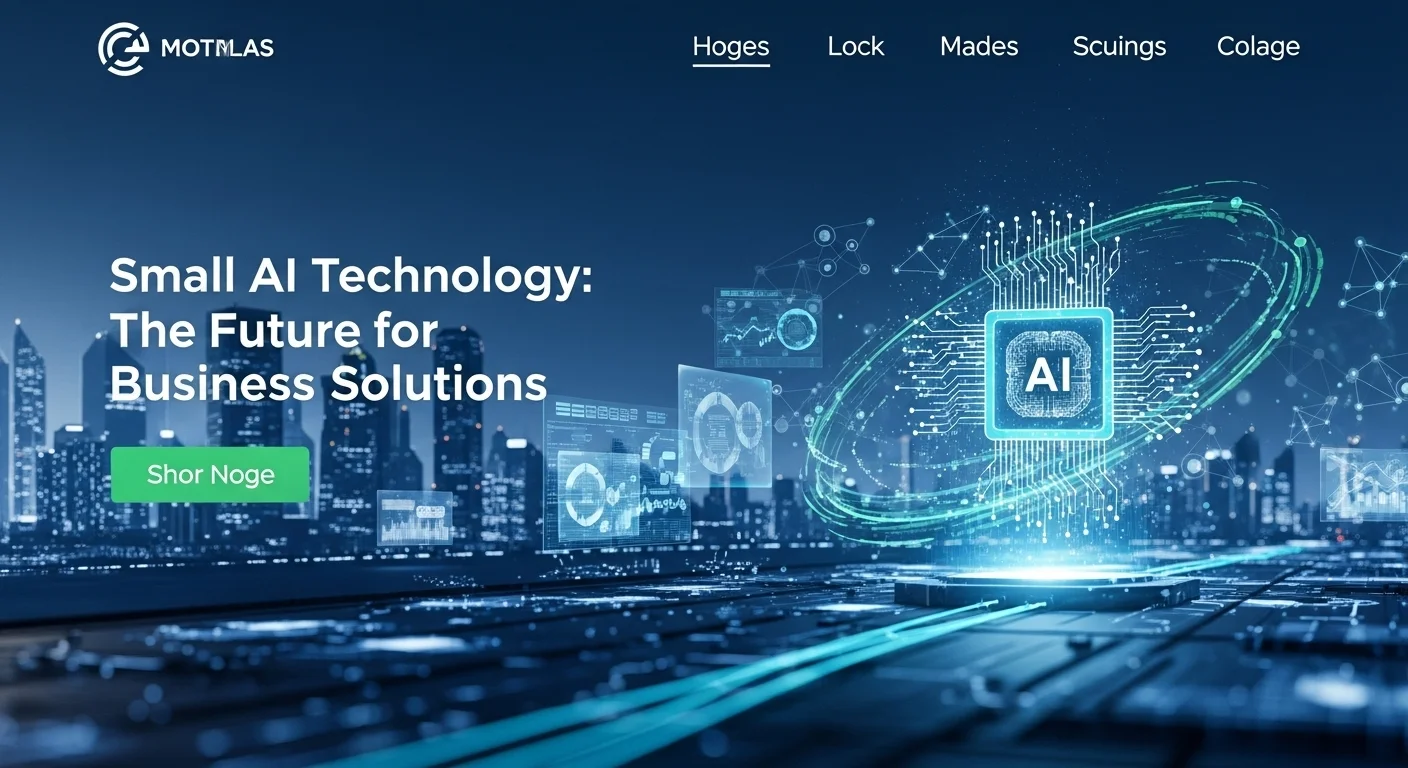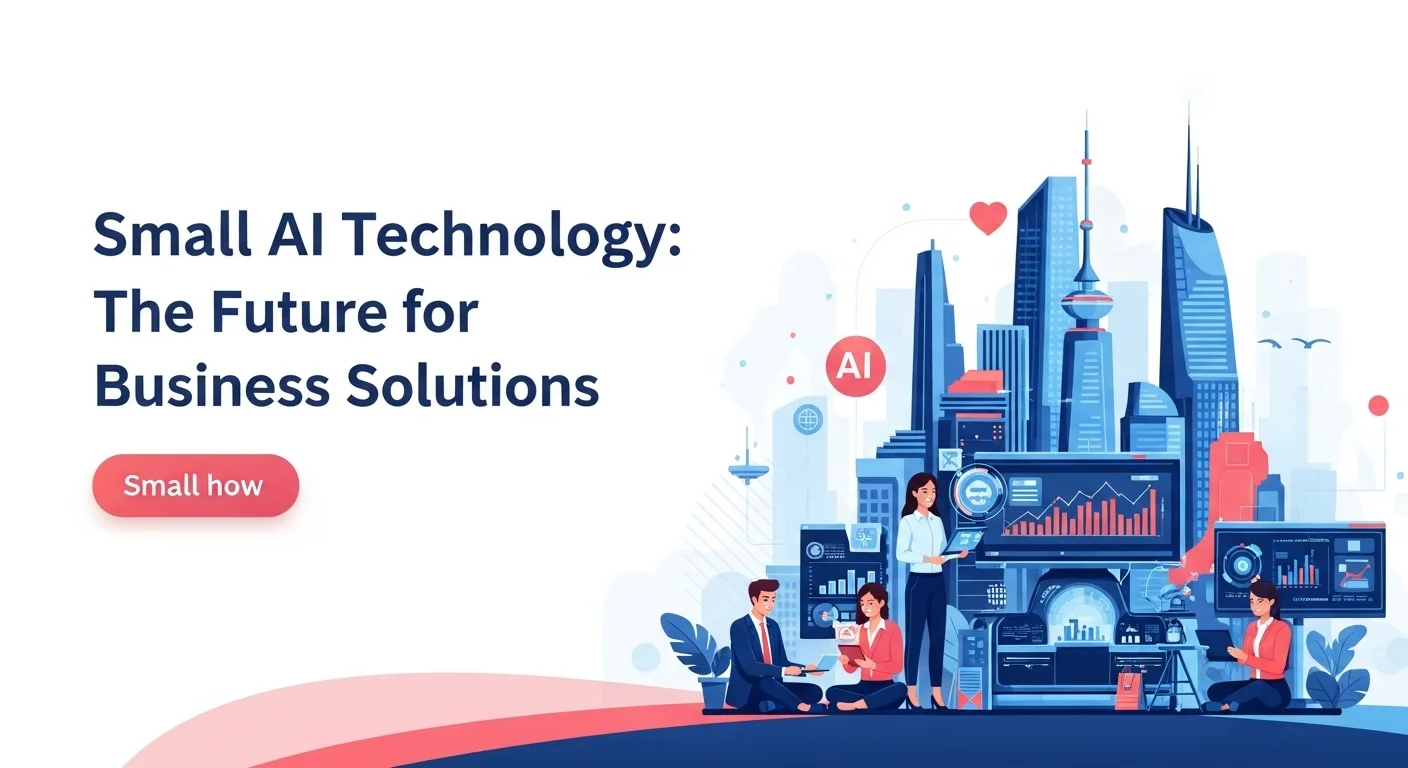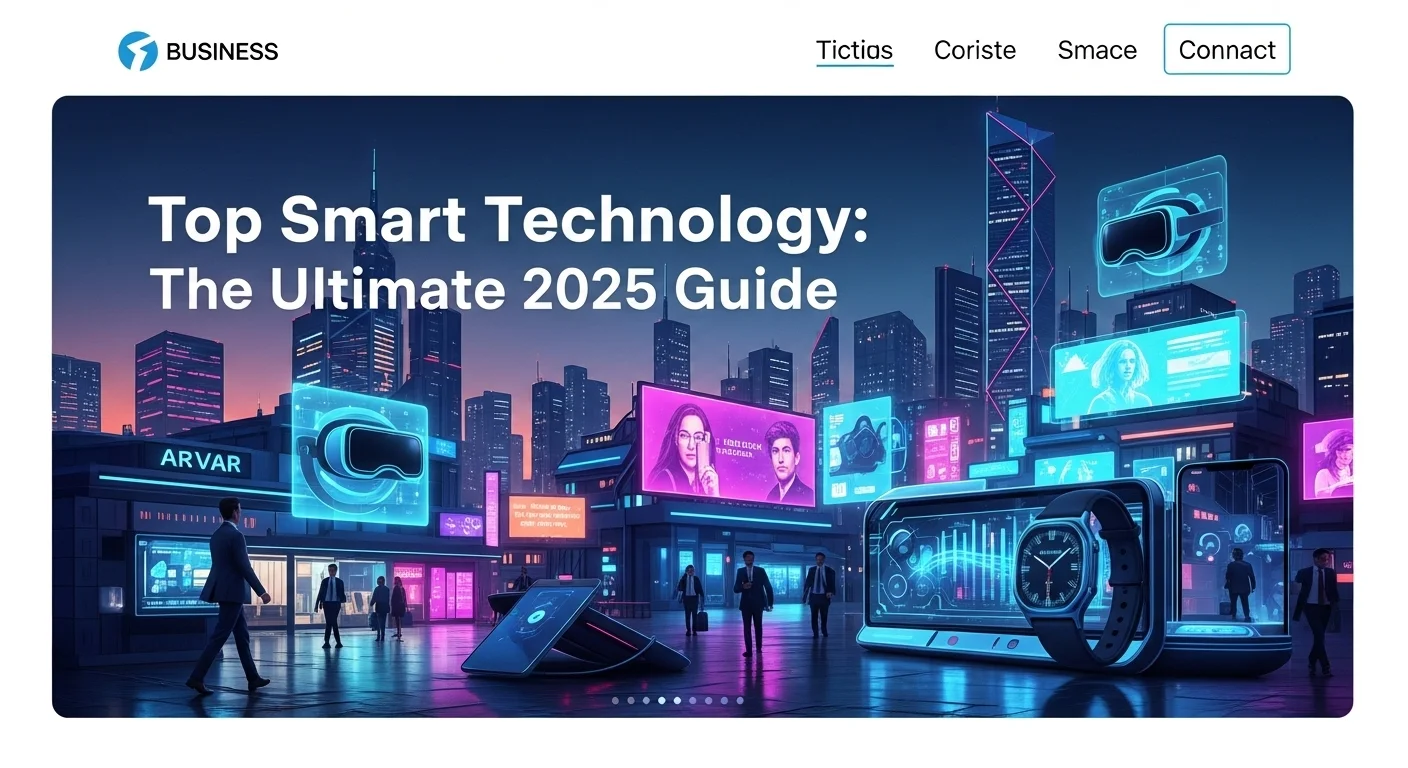Small AI: The Big Revolution Your Business Has Been Waiting For

Executive Summary
For years, I've watched businesses assume that Artificial Intelligence was a game only for the tech giants with endless budgets. But a quiet revolution has been brewing, one that I believe is far more impactful for the rest of us: the rise of 'Small AI'. This isn't just a watered-down version of the big stuff; it's lean, efficient, and specialized AI that's built to do specific jobs incredibly well. It can run on your local devices, saving money and protecting customer privacy. In this article, I'm going to pull back the curtain on this transformative technology. We'll explore what it is, why it's a game-changer, and I'll give you a practical guide on how to use it to supercharge your marketing, streamline your operations, and drive sustainable growth. Welcome to the new frontier of practical, accessible AI.
Table of Contents
- What is Small AI and Why Does It Matter?
- A Complete Guide to Implementing Small AI
- Tips and Strategies to Master Small AI
What is Small AI and Why Does It Matter in Technology?
For a while now, the AI conversation has been all about massive models, the kind that can write poetry or create stunning images. They're impressive, no doubt, but they're also like owning a giant factory machine—incredibly powerful, but expensive, immobile, and resource-hungry. In my experience, a quieter, more practical revolution is happening in the world of Technology, and it’s called Small AI. So, what is it, and why is it quickly becoming a vital tool for business innovation?
At its heart, Small AI refers to artificial intelligence models built for a specific purpose. They are designed to be compact, efficient, and specialized. Think of it this way: instead of that giant factory machine, Small AI is like a precision-engineered Swiss Army knife. It's portable, efficient, and perfectly designed for a specific set of tasks you need on the go. This efficiency isn't about cutting corners; it's achieved through clever optimization techniques like pruning (trimming away unused parts of the AI's network), quantization (using simpler numbers to do the math), and knowledge distillation (where a smaller 'student' model learns from a larger 'teacher' model). The result is a lean but powerful AI that can be deployed in places big AI just can't fit.
The Driving Force Behind Small AI
So, why now? A few key trends are pushing Small AI into the spotlight. First, the explosion of the Internet of Things (IoT) and 'edge' devices. We have billions of smart devices, from watches to industrial sensors, that need to make decisions in real-time. Sending data from a self-driving car or a factory sensor to the cloud and back is just too slow. Small AI solves this by doing the thinking right on the device itself—at the 'edge.' This means faster responses and less reliance on a constant internet connection.
Another massive factor is privacy and security. In a world where data privacy is paramount, keeping sensitive information local is a huge win. A Small AI model can analyze customer data on your local server without ever sending it to an external cloud. For anyone in healthcare, finance, or any business that handles personal info, this is a game-changer. It simplifies compliance with regulations like GDPR and builds trust with customers who are, frankly, tired of their data being sent all over the world. This localized processing is one of the most compelling reasons businesses are looking for the best AI for small business, as it cuts down on significant risk.
Finally, there’s the cost—both financial and environmental. Training a single large AI model can cost millions and has a significant carbon footprint. This has kept advanced AI in the hands of a few tech giants. Small AI changes that. Its lower costs mean that startups, researchers, and small to medium-sized businesses can finally get in the game and build their own custom AI solutions. It's democratizing the technology, making AI for small businesses a practical reality, not just a futuristic dream.
How This Changes Everything for Your Business
For a small or medium-sized business, this shift is monumental. AI goes from being a luxury item to a strategic, accessible tool. Take customer service, for instance. You could deploy a Small AI chatbot on your website that's trained *only* on your products and policies. It can answer most customer questions instantly, 24/7, without the hefty subscription fees of many enterprise platforms. This is a perfect example of an effective AI solution for small business.
In marketing, the possibilities are just as exciting. I've seen e-commerce businesses use a simple Small AI model to analyze browsing behavior in real-time. It can personalize product recommendations on the fly or predict who might abandon their cart, all without expensive third-party tools. This is what effective AI for small business marketing looks like—using your own data intelligently to compete with the big guys.
From an operations standpoint, a small manufacturer could use a simple camera and a computer vision model to spot defects on a production line with superhuman accuracy. A retail shop could analyze foot traffic to optimize its layout. These aren't sci-fi scenarios anymore; they're practical applications made possible by Small AI's efficiency. This paradigm shift from big, centralized AI to small, distributed AI is like the jump from mainframe computers to PCs. It's putting incredible power into the hands of everyone, unleashing a wave of creativity and innovation from the ground up.

A Complete Guide to Implementing Small AI in Your Business
Bringing Small AI into your business isn't just a futuristic idea; it's a practical strategy you can start today to gain a real advantage. This guide is my attempt to demystify the process, from the tech behind it to the strategic steps you can take. Understanding these pieces is the key to finding the best AI for small business and using the right AI software for small business to hit your goals.
The Tech Behind the Magic: How Small AI is Made
Creating these lean AI models isn't just about using less data. It's about using smart techniques to shrink them down without losing their power. Here's a simple breakdown:
1. Pruning: Think of a neural network like a dense bush. After it's fully grown (trained), pruning is like carefully trimming the branches and leaves that aren't helping it thrive. We remove the weakest connections in the AI's 'brain' to make it smaller and faster.
2. Quantization: This is about making the AI's thinking process more efficient. Most AI models use complex 32-bit numbers for their calculations. Quantization simplifies these to less precise but much faster 16-bit or 8-bit numbers. It's like switching from detailed prose to efficient shorthand—you get the point across much quicker, and it's essential for getting AI to run on small devices like your phone.
3. Knowledge Distillation: This is one of my favorite concepts. You take a large, wise 'teacher' model and have it train a smaller 'student' model. The student learns not just the right answers from the data, but also the teacher's nuanced reasoning. The teacher essentially passes down its wisdom, helping the smaller model perform at a level it could never reach on its own. It's a fantastic way to create highly accurate AI solutions for small business.
4. Neural Architecture Search (NAS): Instead of a human trying to design the most efficient AI network, NAS uses an algorithm to do it for us. It tests countless combinations to automatically discover the best possible design for a specific task and device. It's like having an AI design a better AI.
Your Strategic Roadmap for Adopting AI
For a small business, starting with AI can feel overwhelming. I always advise my clients to follow a structured, step-by-step approach. This is how you make AI for small businesses a reality.
Step 1: Find Your High-Impact, Narrow Problem. The golden rule is to not try and solve everything at once. Ask yourself, 'What is the most repetitive, time-consuming, or well-defined task we do?' Is it manually answering the same five customer questions all day? Is it staring at a blank page trying to write a marketing email? Small AI shines when you give it a specific job to do. This focus is how you get a quick, measurable return on your investment.
Step 2: Look at the Data You Already Have. You don't need a Google-sized dataset. Start with what you've got: customer service emails, sales figures, product photos. The key is that it's clean and organized. If your data is a mess, your first project is data cleanup. This groundwork is essential.
Step 3: Explore Off-the-Shelf Tools First. Before you even think about building a custom AI, look at the amazing market of AI software for small business. Many companies offer pre-built AI tools for things like copywriting, social media, and customer support. They've done the hard work, so you can plug in and play. This is often the smartest and most affordable entry point for AI for small business marketing and operations.
Step 4: Run a Pilot Project. Once you've picked a tool, don't roll it out everywhere. Test it in a limited way. Have the AI write ad copy for one campaign and measure the clicks against what you normally do. Use the chatbot for one hour a day and see how it performs. This lets you test the waters and make tweaks before you go all-in.
Step 5: Integrate and Scale. When your pilot project is a success, it's time to weave the AI into your daily workflow. Connect it to your CRM, your e-commerce platform, or whatever systems you use. The goal is to make the AI a seamless assistant, not a separate chore. And remember to check in on it and provide feedback to keep it sharp.
Finding the Right Tools for the Job
The ecosystem of AI tools is vast, but you can navigate it. Here are some of the big names in the space if you decide to get more technical:
Frameworks for Building:
- TensorFlow Lite & PyTorch Mobile: These are the go-to toolkits from Google and Meta for preparing AI models to run on mobile and embedded devices.
- ONNX Runtime: This is a universal translator for AI models, optimized to run them efficiently on almost any hardware. It's a fantastic choice for deploying Small AI everywhere.
Platforms and Services:
- Google's Vertex AI, Amazon SageMaker, Microsoft Azure AI: These are the big cloud platforms. They offer everything from simple, pre-built AI services to powerful tools for building custom models from scratch. Many have 'AutoML' features that make building an optimized model much easier, even without a team of data scientists.
When choosing, a small business has to weigh cost, ease of use, and how much customization they need. My advice? For most, starting with a specialized, pre-built AI software for small business is the best first step. If you have a truly unique problem, then exploring a platform's AutoML features could be your secret weapon. The world of AI for small businesses is officially open for business.

Tips and Strategies to Master Small AI in Your Business
Successfully weaving Small AI into your business is about more than just picking the right software. It's about adopting a strategic mindset and understanding the technology's potential and its limits. From my experience, the right approach can turn a tech experiment into a genuine business advantage. Here are my essential tips and best practices for making Small AI a cornerstone of your success.
Best Practices for Smart Implementation
1. Garbage In, Garbage Out: Prioritize Your Data. I can't stress this enough: any AI is only as good as the data it learns from. Before you start any AI project, take the time to clean, label, and organize your data. It's not the glamorous part, but it's the most important. Create simple, clear rules for how data is collected and stored. This foundational work is non-negotiable for building effective AI solutions for small business.
2. Keep a Human in the Loop. Small AI is incredibly capable, but it's not perfect. In my experience, the most successful AI systems are the ones that augment people, not replace them. Use a 'Human-in-the-Loop' approach. Let the AI do the heavy lifting, but have a person review its work, handle tricky exceptions, and provide feedback. For example, your marketing AI can draft ten email subject lines, and your human marketer picks the best one and refines it. This synergy prevents mistakes and constantly makes the AI smarter. This is often the true mark of the best AI for small business.
3. Demand 'Explainable' AI. AI models can sometimes feel like a 'black box,' where you get an answer but don't know why. Whenever you can, choose tools that offer some level of explainability. If an AI predicts a customer might leave, knowing *why* (e.g., they had a recent support issue or haven't logged in for a month) is incredibly powerful. It helps you trust the system and gives you actionable insights you can use.
4. Double Down on Security and Privacy. Small AI's ability to run on your local devices is great for privacy, but that device still needs to be secure. Make sure you're following strong cybersecurity practices on all your devices: use strong passwords, keep software updated, and secure your network. When you're evaluating an AI software for small business, read their security and data policies carefully. A data breach can be fatal for a small company, so this can never be an afterthought.
Finding the Right Tools for the Job
The AI tool market is noisy. Here's how I advise clients to cut through the chatter and find what actually works.
Start With the Tools You Already Use: Before you go shopping for something new, check the platforms you're already paying for. Your CRM (like HubSpot), your e-commerce site (like Shopify), and your email marketing tool are likely already adding Small AI features. Shopify Magic can help write product descriptions, and HubSpot has AI assistants for drafting content. Using these integrated tools is often the easiest and cheapest way to get started since they're already connected to your data.
Use Free Trials Like a Scientist: So many of the best AI software for small business platforms offer free trials or 'freemium' plans. Use them! Set up a small experiment. Test two or three AI social media tools for a month and compare the real-world results. Which one saved you more time? Which one got better engagement? This hands-on experience is worth more than any sales page.
Look for Specialists: I've found that the most effective Small AI tools are often hyper-focused. A tool built just for e-commerce marketing will almost always beat a generic AI writer at that specific task. When you search, be specific. Instead of 'AI for business,' try 'AI to predict inventory for my restaurant' or 'AI that summarizes legal documents for small firms.' This will lead you to powerful niche solutions.
Read Reviews from People Like You: Look for real stories from businesses that are your size and in your industry. Case studies and reviews on industry forums are gold. A rave review from a massive corporation isn't nearly as useful as a detailed story from another small business owner who faced the same challenges you do.
A High-Quality External Resource to Check Out
For leaders who want to go deeper, I often recommend the 'AI for Business' series from publications like Harvard Business Review. They focus on strategy over tech-speak. A fantastic and accessible starting point is the 'AI for Business: A (non-technical) introduction' video on YouTube. It's great at breaking down the core concepts and provides a simple framework for applying AI, which is perfect for small businesses.
Staying Ahead of the Curve
The world of AI moves fast. The key is to build a culture of learning and experimentation. Encourage your team to play with new tools. Set aside a tiny 'innovation' budget to test emerging technologies. Keep an eye on trends that will make these tools even more powerful. By adopting a mindset of strategic curiosity, your business won't just keep up; it will be ready to lead with the best AI for small business technology, today and tomorrow.
Expert Reviews & Testimonials
Sarah Johnson, Business Owner ⭐⭐⭐
The information about Small AI is good, but I wish there were more practical, real-world examples for business owners like me.
Mike Chen, IT Consultant ⭐⭐⭐⭐
A helpful article on Small AI. It clarified a lot for me, though some technical parts could have been explained a bit more simply.
Emma Davis, Tech Expert ⭐⭐⭐⭐⭐
Excellent article! It's a very comprehensive look at Small AI. It was a huge help for my specialization, and I found it perfectly clear.



